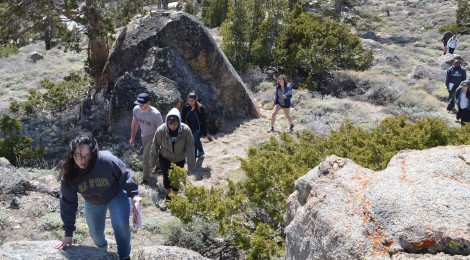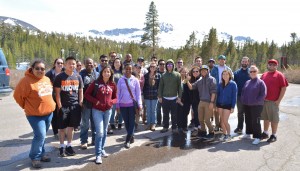
Ecology students climb to the top of the world
When you stand on top of the Sierra Nevada mountains it’s like you’ve been transported to the top of the world. So much so you might even forget about those exams coming up! Ok, so maybe that’s an exaggeration – but you get the picture!
 The Sierra Nevada mountain range is a world that’s vast in its extent and striking in its beauty. Extending approximately 400 miles north to south, ranging 60-80 miles wide, and rising in elevation to over 14,000 feet, it is a major landscape feature that dictates much of the conditions for life in the state. Its massive rugged peaks, deeply carved valleys, and tremendous diversity of life also make it the perfect outdoor classroom for ecology!
The Sierra Nevada mountain range is a world that’s vast in its extent and striking in its beauty. Extending approximately 400 miles north to south, ranging 60-80 miles wide, and rising in elevation to over 14,000 feet, it is a major landscape feature that dictates much of the conditions for life in the state. Its massive rugged peaks, deeply carved valleys, and tremendous diversity of life also make it the perfect outdoor classroom for ecology!
Our all-day Saturday trip took us from Sacramento State in the Central Valley at about 25 ft elevation, all the way up to Carson Pass at 8,574 ft. On our journey we passed through a wide range of climate zones, habitat conditions and vegetation communities. We saw grassland, oak woodland, chaparral, coniferous forests, alpine tundra and more. During our climb we learned about the geologic history, climate variation, and the diverse plant and animal species that inhabit the Sierra Nevada and are adapted to its wide range of habitats.
When we arrived at the top, the sun was bright, the wind was cool and the scenery immersive. The power of this landscape, our place in it and our magnificent vantage point at the top of the world was well worth the climb!


